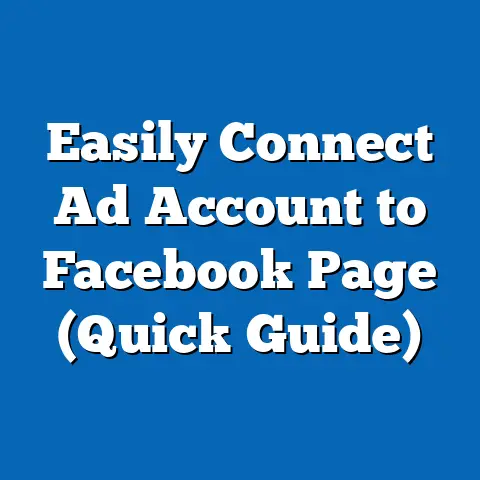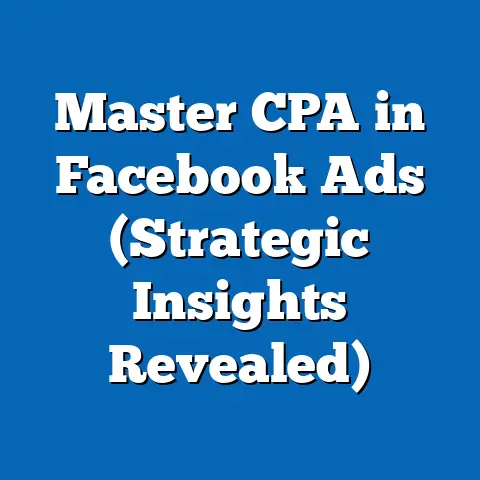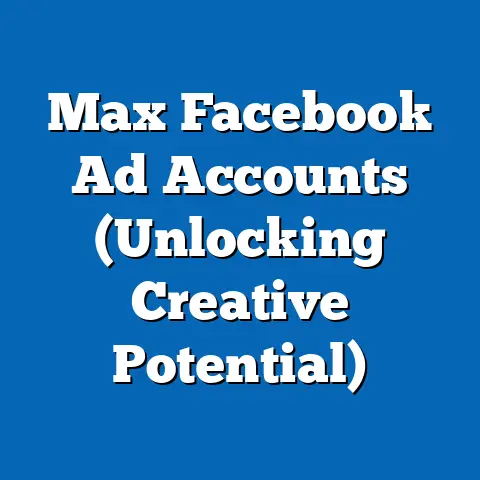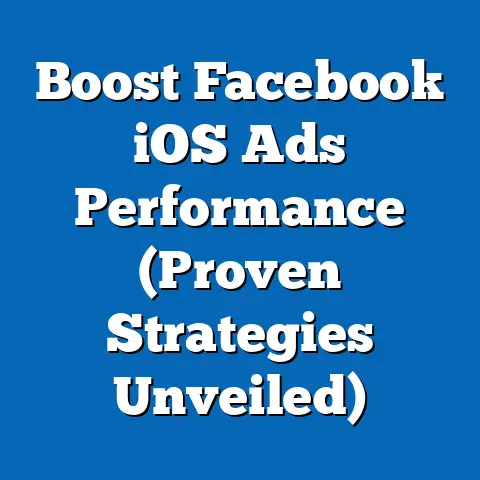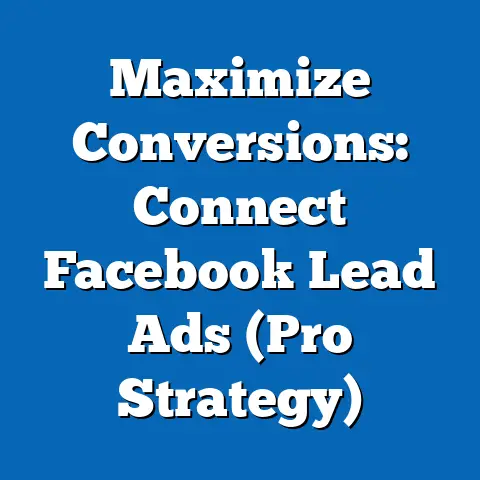Master Facebook Ads in-person (Proven Strategies Unveiled)
I remember the first time I truly understood the power of Facebook Ads. I was working with a small, family-owned bakery in my neighborhood. Their cakes were incredible, their pastries divine, but their customer base was dwindling. They were on the verge of closing. We tried everything – flyers, local newspaper ads, even sponsoring a little league team. Nothing seemed to stick. Then, we decided to give Facebook Ads a try. It felt like a last-ditch effort, a digital Hail Mary.
We crafted a simple ad featuring a mouth-watering photo of their signature chocolate cake, targeted at people within a 5-mile radius who had expressed interest in baking, desserts, or local businesses. The results were… underwhelming at first. We were ready to throw in the towel. But something told me to keep tweaking, to keep testing.
Then, it happened. We changed the ad copy to focus on the emotional connection people had with their cakes – memories, celebrations, family gatherings. We highlighted that their bakery wasn’t just selling desserts, but creating moments. Suddenly, the clicks started coming, the orders poured in, and the bakery was buzzing with life again. They went from struggling to keep the lights on to needing to hire extra staff to keep up with demand.
That’s when I realized that Facebook Ads wasn’t just about algorithms and targeting – it was about understanding people, connecting with their emotions, and offering them something truly valuable. This isn’t just about selling; it’s about building relationships and contributing to a community. In this guide, I’ll share the proven strategies I’ve learned over the years, strategies that go beyond the technicalities and tap into the human element of advertising. So, let’s dive in and unlock the potential of Facebook Ads together.
Understanding the Facebook Ads Ecosystem
Before we jump into the nitty-gritty strategies, it’s crucial to have a solid grasp of the Facebook Ads ecosystem. Think of it as the foundation upon which your advertising empire will be built. Without a strong foundation, your efforts are likely to crumble. Let’s break down the key components:
Ad Formats: Choosing the Right Canvas for Your Message
Facebook offers a plethora of ad formats, each with its own unique strengths and weaknesses. Choosing the right format is like selecting the perfect canvas for a painting – it can drastically impact how your message is received. Here are a few of the most popular formats:
- Carousel Ads: These allow you to showcase multiple images or videos in a single ad, each with its own headline, description, and link. I’ve found these to be particularly effective for e-commerce businesses looking to highlight different products or features. Think of it as a mini-catalog within an ad.
- Single Image/Video Ads: These are the bread and butter of Facebook Ads, perfect for conveying a simple, focused message. A high-quality image or a captivating video can work wonders, especially when paired with compelling copy.
- Slideshow Ads: These combine multiple images or videos into a dynamic slideshow, often with music or transitions. They’re a great way to tell a story or showcase a product in action without the cost of a full-blown video production.
- Collection Ads: These are designed for mobile shoppers, allowing them to browse a catalog of products directly within the ad. When clicked, they open a full-screen Instant Experience, providing a seamless shopping experience.
- Instant Experience Ads: Formerly known as Canvas Ads, these offer a full-screen, immersive experience that loads instantly on mobile devices. They’re perfect for telling a brand story, showcasing a product in detail, or driving conversions.
Takeaway: Experiment with different ad formats to see which ones resonate best with your audience and align with your campaign objectives. There is no one-size-fits-all solution.
Targeting Options: Finding Your Ideal Customer
Targeting is arguably the most powerful aspect of Facebook Ads. It allows you to laser-focus your message on the people who are most likely to be interested in your product or service. Forget casting a wide net; Facebook Ads lets you use a fishing rod with laser precision. Here are some of the key targeting options:
- Demographics: Target based on age, gender, location, education, job title, and more. This is the basic building block of your audience.
- Interests: Target based on the pages people have liked, the topics they follow, and the things they’ve expressed interest in on Facebook. This is where you start to get more granular.
- Behaviors: Target based on people’s online behavior, such as purchase history, device usage, and travel habits. This allows you to reach people who are actively looking for products or services like yours.
- Custom Audiences: This is where the magic truly happens. You can upload your own customer data (email addresses, phone numbers) to create a custom audience, or create a lookalike audience based on your existing customers.
- Lookalike Audiences: Facebook analyzes your existing customer data and finds people who share similar characteristics and behaviors. This is a powerful way to expand your reach and find new customers who are likely to convert.
Crafting an Ideal Customer Persona: Before you start targeting, take the time to create a detailed customer persona. This is a fictional representation of your ideal customer, based on research and data. Give them a name, a job, a family, hobbies, and motivations. The more detailed your persona, the better you’ll be able to target your ads effectively.
Takeaway: Don’t just guess at your targeting. Use data and research to understand your audience and create a detailed customer persona. The more specific you are, the better your results will be.
Ad Placement: Where Your Message Will Live
Facebook Ads can appear in a variety of placements, including:
- Facebook Feed: This is the most common placement, appearing directly in users’ news feeds.
- Instagram Feed: Another popular placement, especially for visually-driven products or services.
- Facebook Marketplace: A great option for reaching people who are actively looking to buy or sell products.
- Instagram Explore: This placement allows you to reach people who are browsing Instagram for new content.
- Audience Network: This allows you to extend your reach beyond Facebook and Instagram to a network of third-party websites and apps.
Choosing the Right Placement: The best placement will depend on your target audience, ad format, and campaign objectives. For example, if you’re targeting a younger audience with visually-driven content, Instagram Feed might be the best option. If you’re selling products locally, Facebook Marketplace could be a good choice.
Takeaway: Don’t just blindly choose all placements. Consider your target audience and campaign objectives to determine the most effective placements for your ads.
Proven Strategies for Success
Now that we have a solid understanding of the Facebook Ads ecosystem, let’s dive into some proven strategies that can help you achieve success. These are the tactics I’ve used time and time again to drive results for my clients.
Crafting Compelling Copy: Words That Sell
Your ad copy is the first thing people will see, and it needs to grab their attention and persuade them to take action. Think of it as your elevator pitch – you have a limited amount of time to make a lasting impression. Here are some tips for writing compelling ad copy:
- Know Your Audience: Tailor your copy to the specific interests and needs of your target audience. Use language they understand and address their pain points.
- Highlight the Benefits: Don’t just list the features of your product or service; focus on the benefits. How will it make their life better? What problem will it solve?
- Use Strong Verbs: Use action words that create a sense of urgency and excitement. Words like “discover,” “transform,” “unlock,” and “achieve” can be highly effective.
- Keep it Concise: People have short attention spans, so get to the point quickly. Use short sentences and paragraphs to make your copy easy to read.
- Include a Clear Call-to-Action (CTA): Tell people exactly what you want them to do. Use strong CTAs like “Shop Now,” “Learn More,” “Sign Up,” or “Get Started.”
The Power of Storytelling: People are naturally drawn to stories. Consider using storytelling techniques in your ad copy to connect with your audience on an emotional level. Share a customer testimonial, tell a personal anecdote, or create a fictional scenario that resonates with their experiences.
Takeaway: Your ad copy is your sales pitch. Make it compelling, concise, and focused on the benefits of your product or service.
Visuals That Captivate: Attracting Attention in a Scroll-Filled World
In the visually-driven world of social media, your ad visuals are just as important as your copy. A compelling image or video can stop people in their tracks and make them want to learn more. Here are some tips for creating captivating visuals:
- Use High-Quality Images: Avoid blurry or pixelated images. Use high-resolution images that are clear, crisp, and visually appealing.
- Choose Relevant Images: Make sure your images are relevant to your product or service and your target audience.
- Use Eye-Catching Colors: Use bright, bold colors that stand out from the feed.
- Include People: Images of people tend to be more engaging than images of products alone.
- Consider Video: Video is a highly engaging format that can be used to tell a story, demonstrate a product, or capture attention.
Design Tips and Tools: You don’t need to be a professional designer to create effective ad visuals. There are many free or affordable design tools available online, such as Canva, Adobe Spark, and PicMonkey. These tools offer pre-designed templates and easy-to-use features that can help you create stunning visuals in minutes.
Takeaway: Your ad visuals are your first impression. Make them count by using high-quality images and videos that are relevant, eye-catching, and engaging.
A/B Testing: The Key to Optimization
A/B testing, also known as split testing, is the process of comparing two versions of an ad to see which one performs better. This is a crucial step in optimizing your ad performance and maximizing your ROI. Here are some things you can A/B test:
- Headlines: Test different headlines to see which ones grab the most attention and drive the most clicks.
- Images/Videos: Test different visuals to see which ones are most engaging and relevant to your audience.
- Ad Copy: Test different ad copy to see which one resonates best with your audience and persuades them to take action.
- Call-to-Actions (CTAs): Test different CTAs to see which ones drive the most conversions.
- Targeting: Test different targeting options to see which ones are most effective at reaching your ideal customer.
Interpreting the Results: Once you’ve run your A/B test, it’s important to analyze the results and draw meaningful conclusions. Look at key metrics like click-through rate (CTR), conversion rate, and cost per acquisition (CPA) to determine which version of your ad performed better.
Takeaway: A/B testing is an ongoing process. Continuously test different elements of your ads to see what works best and optimize your performance over time.
Budgeting Wisely: Making Every Dollar Count
Setting and managing your ad budget effectively is crucial for maximizing your ROI. You don’t want to spend too much and waste money, but you also don’t want to spend too little and miss out on potential customers. Here are some strategies for budgeting wisely:
- Daily vs. Lifetime Budgets: Facebook offers two budgeting options: daily budgets and lifetime budgets. A daily budget allows you to spend a certain amount each day, while a lifetime budget allows you to spend a certain amount over the entire duration of your campaign.
- Start Small and Scale Up: When you’re first starting out, it’s best to start with a small budget and gradually scale up as you see results. This allows you to test different strategies and optimize your performance without risking too much money.
- Monitor Your Performance: Keep a close eye on your ad performance and adjust your budget accordingly. If you’re seeing good results, you can increase your budget to reach more people. If you’re not seeing results, you can decrease your budget or pause your campaign altogether.
- Consider Your Campaign Objectives: Your budget should be aligned with your campaign objectives. If you’re trying to drive brand awareness, you might be willing to spend more per impression than if you’re trying to drive direct sales.
Takeaway: Budgeting is not a set-it-and-forget-it process. Monitor your performance regularly and adjust your budget accordingly to maximize your ROI.
Real-Life Case Studies
Let’s take a look at a few real-life examples of businesses that have successfully implemented Facebook Ads strategies.
Case Study 1: The Local Coffee Shop
A local coffee shop was struggling to compete with larger chains. They decided to run a Facebook Ad campaign targeting people within a 2-mile radius who had expressed interest in coffee, breakfast, or local businesses. They used a single image ad featuring a photo of their signature latte and the headline “Start Your Day Right with [Coffee Shop Name].” They A/B tested different ad copy and targeting options, eventually finding a winning combination that drove a significant increase in foot traffic and sales.
Case Study 2: The Online Clothing Boutique
An online clothing boutique wanted to increase their brand awareness and drive sales. They ran a Carousel Ad campaign showcasing their latest collection, targeting women aged 18-35 who had expressed interest in fashion, online shopping, or specific clothing brands. They used high-quality images and compelling ad copy, and they offered a discount code for first-time buyers. The campaign resulted in a significant increase in website traffic, social media engagement, and sales.
Takeaway: These case studies demonstrate the power of Facebook Ads when used strategically. By understanding your target audience, crafting compelling copy and visuals, and continuously optimizing your campaigns, you can achieve significant results.
The Importance of Continual Learning and Adaptation
The world of social media marketing is constantly evolving. Facebook is always rolling out new features, algorithms are changing, and trends are shifting. To stay ahead of the curve, it’s crucial to embrace continual learning and adaptation.
- Stay Updated with Facebook’s Algorithm Changes: Facebook’s algorithm determines which ads are shown to which users. Understanding how the algorithm works is essential for optimizing your ad performance.
- Embrace New Ad Features: Facebook is constantly introducing new ad features and formats. Be sure to stay updated on these changes and experiment with new features to see how they can benefit your campaigns.
- Follow Industry Trends: Keep an eye on the latest trends in social media marketing. What’s working for other businesses? What are people talking about?
- Attend Courses and Webinars: There are many online courses and webinars that can help you improve your Facebook Ads skills.
- Read Industry Blogs: Follow industry blogs and publications to stay up-to-date on the latest news and trends.
Takeaway: The only constant in social media marketing is change. Embrace continual learning and adaptation to stay ahead of the curve and maximize your results.
Conclusion
Mastering Facebook Ads is not about becoming a technical wizard; it’s about understanding people, connecting with their emotions, and offering them something truly valuable. It’s about crafting compelling stories, creating captivating visuals, and continuously optimizing your campaigns to achieve the best possible results. It’s about remembering that behind every click, every conversion, every sale, there’s a real person with real needs and desires.
Remember the bakery I mentioned at the beginning? Their success wasn’t just about the ads; it was about the heart they poured into their craft, the love they had for their community, and the willingness to connect with people on a personal level. That’s the secret sauce – the human element.
So, take the strategies I’ve shared, experiment, adapt, and never stop learning. The potential for success is there, waiting to be unlocked. And remember, every great journey begins with a single step. What are you waiting for? Let’s get started!

